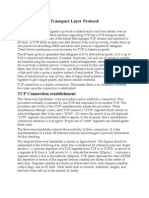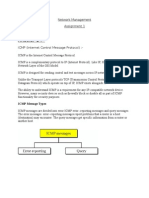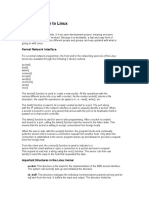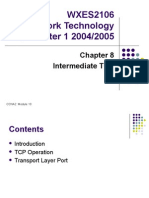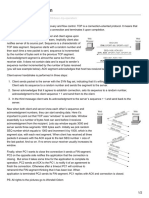TCP Connection Establishment Process: The "Three-Way Handshake"
TCP Connection Establishment Process: The "Three-Way Handshake"
Uploaded by
Sameer PandeyCopyright:
Available Formats
TCP Connection Establishment Process: The "Three-Way Handshake"
TCP Connection Establishment Process: The "Three-Way Handshake"
Uploaded by
Sameer PandeyOriginal Title
Copyright
Available Formats
Share this document
Did you find this document useful?
Is this content inappropriate?
Copyright:
Available Formats
TCP Connection Establishment Process: The "Three-Way Handshake"
TCP Connection Establishment Process: The "Three-Way Handshake"
Uploaded by
Sameer PandeyCopyright:
Available Formats
TCP Connection Establishment Process: The "Three-Way Handshake"
We have discussed in earlier topics in this section the connection orientation of TCP and its operation. Before TCP
can be employed for any actually useful purposethat is, sending dataa connection must be set up between the
two devices that wish to communicate. This process, usually called connection establishment, involves an exchange
of messages that transitions both devices from their initial connection state (CLOSED) to the normal operating state
(ESTABLISHED).
Connection Establishment Functions
The connection establishment process actually accomplishes several things as it creates a connection suitable for
data exchange:
o
Contact and Communication: The client and server make contact with each other and establish
communication by sending each other messages. The server usually doesnt even know what client it will be
talking to before this point, so it discovers this during connection establishment.
Sequence Number Synchronization: Each device lets the other know what initial sequence number it
wants to use for its first transmission.
Parameter Exchange: Certain parameters that control the operation of the TCP connection are exchanged
by the two devices.
TCP Connection Establishment Process: The "Three-Way Handshake"
Control Messages Used for Connection Establishment: SYN and ACK
TCP uses control messages to manage the process of contact and communication. There aren't, however, any
special TCP control message types; all TCP messages use the same segment format. A set of control flags in the
TCP header indicates whether a segment is being used for control purposes or just to carry data. As I introduced in
the discussion of the TCP finite state machine, two control message types are used in connection setup, which are
specified by setting the following two flags:
o
SYN: This bit indicates that the segment is being used to initialize a connection. SYN stands for
synchronize, in reference to the sequence number synchronization I mentioned above.
ACK: This bit indicates that the device sending the segment is conveying an acknowledgment for a
message it has received (such as a SYN).
There are also other control bits (FIN, RST, PSH and URG), which aren't important to connection establishment, so
we will set them aside for now. We'll discuss them in other topics. In common TCP parlance, a message with a
control bit set is often named for that bit. For example, if the SYN control bit is set the segment is often called a SYN
message. Similarly, one with the ACK bit set is an ACK message or even just an ACK.
TCP Connection Establishment Process: The "Three-Way Handshake"
Normal Connection Establishment: The "Three Way Handshake"
To establish a connection, each device must send a SYN and receive an ACK for it from the other device. Thus,
conceptually, we need to have four control messages pass between the devices. However, it's inefficient to send a
SYN and an ACK in separate messages when one could communicate both simultaneously. Thus, in the normal
sequence of events in connection establishment, one of the SYNs and one of the ACKs is sent together by setting
both of the relevant bits (a message sometimes called a SYN+ACK). This makes a total of three messages, and for
this reason the connection procedure is called a three-way handshake.
Key Concept: The normal process of establishing a connection between a TCP client and server involves three
steps: the client sends a SYN message; the server sends a message that combines an ACK for the clients SYN
and contains the servers SYN; and then the client sends an ACK for the servers SYN. This is called the TCP
three-way handshake.
Table 152 describes in detail how the three-way handshake works (including a summary of the preparation discussed
in the previous topic). It is adapted from the table describing the TCP finite state machine, but shows what happens
for both the server and the client over time. Each row shows the state the device begins in, what action it takes in that
state and the state to which it transitions. The transmit and receive parts of each of the three steps of the handshake
process are shown in the table, as well as in Figure 211.
Table 152: TCP Three-Way Handshake Connection Establishment Procedure
Client
Start State
Action
Server
Move To State
Start State
CLOSED
The client cannot do
anything until the
server has
performed a passive
OPEN and is ready
to accept a
connection. (Well, it
can try, but nothing
will be
accomplished until
the server is ready.)
CLOSED
CLOSED
Step #1 Transmit:
The client performs
an active OPEN,
creating a
transmission control
block (TCB) for the
connection and
sending a SYN
message to the
server.
SYN-SENT
LISTEN
LISTEN
SYN-SENT
The client waits to
receive an ACK to
the SYN it has sent,
Action
The server
performs a passive
OPEN, creating a
transmission
control block (TCB)
for the connection
and readying itself
for the receipt of a
connection request
(SYN) from a
client.
The server waits
for contact from a
client.
Step #1 Receive,
Step #2 Transmit:
The server
Move To State
LISTEN
SYN-
receives the SYN
from the client. It
sends a single
SYN+ACK
message back to
the client that
contains an ACK
for the client's
SYN, and the
server's own SYN.
RECEIVED
SYNRECEIVED
The server waits
for an ACK to the
SYN it sent
previously.
SYNRECEIVED
Step #3 Receive:
The server
receives the ACK
to its SYN and is
now done with
connection
establishment.
ESTABLISHED
as well as the
server's SYN.
SYN-SENT
Step #2 Receive,
Step #3 Transmit:
The client receives
from the server the
SYN+ACK
containing the ACK
to the client's SYN,
and the SYN from
the server. It sends
the server an ACK
for the server's
SYN. The client is
now done with the
connection
establishment.
ESTABLISHED
The client is waiting
for the server to
finish connection
establishment so
they can operate
normally.
ESTABLISHED
The client is ready
for normal data
transfer operations.
ESTABLISHED
ESTABLISHED
The server is
ready for normal
data transfer
operations.
Figure 211: TCP Three-Way Handshake Connection Establishment Procedure
This diagram illustrates how a conventional connection is established between a client and server, showing the
three messages sent during the process and how each device transitions from the CLOSED state through
intermediate states until the session is ESTABLISHED.
You might also like
- Presentation 1 INTRODUCTION TO DIGITAL AGE PDFDocument15 pagesPresentation 1 INTRODUCTION TO DIGITAL AGE PDFLive Love100% (1)
- Week 3 - Introduction To Transport & Application LayersDocument3 pagesWeek 3 - Introduction To Transport & Application LayersJamesNo ratings yet
- Huawei LTE RFPDocument23 pagesHuawei LTE RFPSoufiane Falih100% (3)
- CN NotesDocument10 pagesCN Notesbhavya gNo ratings yet
- Three Way HandshakeDocument2 pagesThree Way Handshakemktknp575No ratings yet
- Connection EstablishDocument7 pagesConnection EstablishshanzaNo ratings yet
- TCP Operational Overview and The TCP Finite State Machine (FSM)Document4 pagesTCP Operational Overview and The TCP Finite State Machine (FSM)Mayank JaitlyNo ratings yet
- TCP Connection ManagementDocument5 pagesTCP Connection ManagementBALARAMAN NNo ratings yet
- Expt 6 - Analysis of TCP ProtocolDocument8 pagesExpt 6 - Analysis of TCP ProtocolAadrika GuptaNo ratings yet
- 3 way- handshake protocolDocument4 pages3 way- handshake protocolnagomiyasNo ratings yet
- imp topicsDocument2 pagesimp topicsKashmeera RNo ratings yet
- TCP 3-Way Handshake (SYN, SYN-ACK, ACK) Day 6Document3 pagesTCP 3-Way Handshake (SYN, SYN-ACK, ACK) Day 6aa6692181No ratings yet
- Lecture 6Document6 pagesLecture 6Rylan2911No ratings yet
- 21bai020 CNDocument15 pages21bai020 CNns4676No ratings yet
- Exp 5Document4 pagesExp 5neha yarrapothuNo ratings yet
- Networking Unit-IVDocument23 pagesNetworking Unit-IVthirosulNo ratings yet
- TCP 3-Way HandshakeDocument3 pagesTCP 3-Way Handshakeakademi menembakNo ratings yet
- Unit 4 Lec3Document11 pagesUnit 4 Lec3SangetaNo ratings yet
- CN Unit VDocument35 pagesCN Unit VvijayNo ratings yet
- Computer Networks (CS425) : Transport Layer ProtocolDocument3 pagesComputer Networks (CS425) : Transport Layer ProtocolAnish VeettiyankalNo ratings yet
- Module 5 Transport LayerDocument9 pagesModule 5 Transport Layerdhruu2503No ratings yet
- EE CN Lab Munual 5Document10 pagesEE CN Lab Munual 5oman buttNo ratings yet
- Transport Layer Protocol: What Is TCP?Document16 pagesTransport Layer Protocol: What Is TCP?Clarita PintoNo ratings yet
- System Internal Controls Management AccountantsDocument13 pagesSystem Internal Controls Management AccountantsAshok JoonNo ratings yet
- TCP (Transmission Control Protocol)Document2 pagesTCP (Transmission Control Protocol)Pratheek RaoNo ratings yet
- CN 4Document22 pagesCN 4S M AkashNo ratings yet
- Which Protocol Is Known As TheDocument1 pageWhich Protocol Is Known As TheAkash Rudra PaulNo ratings yet
- Network Management 001Document7 pagesNetwork Management 001Gourav BansalNo ratings yet
- Wireshark TCPDocument5 pagesWireshark TCPWarid FarooqNo ratings yet
- Lab 4handoutDocument11 pagesLab 4handoutAlamgir KhanNo ratings yet
- Introduction To Linux: Kernel Network InterfaceDocument13 pagesIntroduction To Linux: Kernel Network Interfacemmadhav33No ratings yet
- A TCP TutorialDocument11 pagesA TCP Tutorialpfck4589No ratings yet
- TCP Transmission Control ProtocolDocument25 pagesTCP Transmission Control ProtocolMaelef GetuNo ratings yet
- Unit 3 Exam CN NotesDocument20 pagesUnit 3 Exam CN NotesChandrabhushan kumarNo ratings yet
- CN_-4Document7 pagesCN_-4ArshadNo ratings yet
- UNIT 4 TRANSPORT LAYER PROTOCOLDocument11 pagesUNIT 4 TRANSPORT LAYER PROTOCOLVedant KawadeNo ratings yet
- HC110110006 Transport Layer ProtocolsDocument16 pagesHC110110006 Transport Layer ProtocolsAsmaa BoughraraNo ratings yet
- Module 5-6: Manages The Rate of Data Transmission Using The Receiver's Window Size (RWND) To AvoidDocument16 pagesModule 5-6: Manages The Rate of Data Transmission Using The Receiver's Window Size (RWND) To AvoidKhan FardeenNo ratings yet
- Ex - No:5-C Date: Study of Udp/Tcp PerformanceDocument16 pagesEx - No:5-C Date: Study of Udp/Tcp PerformanceMurali RamasamyNo ratings yet
- Unit 1Document39 pagesUnit 1SundariNo ratings yet
- WXES2106 Network Technology Semester 1 2004/2005: Intermediate TCPDocument23 pagesWXES2106 Network Technology Semester 1 2004/2005: Intermediate TCPapi-19663123No ratings yet
- ITT420 - Chapter 7 TCPDocument58 pagesITT420 - Chapter 7 TCPnurul najwaNo ratings yet
- Transmission Control Protocol (TCP) : Reliable Connection-Oriented Point-To-Point Full-Duplex Streams, Not MessagesDocument25 pagesTransmission Control Protocol (TCP) : Reliable Connection-Oriented Point-To-Point Full-Duplex Streams, Not Messagesarunnair2006No ratings yet
- Computer Networks (CS425) : Transport Layer Protocol-Implementation IssuesDocument5 pagesComputer Networks (CS425) : Transport Layer Protocol-Implementation IssuesAnish VeettiyankalNo ratings yet
- 2310-01-SYN FloodingDocument10 pages2310-01-SYN FloodingNM ThânNo ratings yet
- Transport LayerDocument33 pagesTransport Layerharsharewards1No ratings yet
- 4.1 TCP & UDPDocument59 pages4.1 TCP & UDPkatyaini1511No ratings yet
- TCP - 01Document9 pagesTCP - 01bscs23034No ratings yet
- UNIT IV-Transport LayerDocument24 pagesUNIT IV-Transport LayerSenthilkumar SNo ratings yet
- Chapter 4 TransportLayerDocument44 pagesChapter 4 TransportLayerSebunya RonaldoNo ratings yet
- Unit V Part-1 Transport Layer ServicesDocument13 pagesUnit V Part-1 Transport Layer ServicesMalliNo ratings yet
- TCP 1Document46 pagesTCP 1Arun Kumar SinghNo ratings yet
- Unit 4 Lec4Document19 pagesUnit 4 Lec4SangetaNo ratings yet
- Unit 4 Lec2Document12 pagesUnit 4 Lec2SangetaNo ratings yet
- TCP Slow StartDocument8 pagesTCP Slow StartPradeep SramNo ratings yet
- CN Unit-5 MaterialDocument27 pagesCN Unit-5 MaterialsuneelkluNo ratings yet
- Basic TCP OperationDocument2 pagesBasic TCP Operationtsegay.csNo ratings yet
- Unit 4Document101 pagesUnit 4vaibhavsaxena599No ratings yet
- Distinguish Between Network and Transport LayerDocument11 pagesDistinguish Between Network and Transport LayerKailash SanthakumarNo ratings yet
- Unit 10: Transport LayerDocument8 pagesUnit 10: Transport LayeryogeshdeoNo ratings yet
- TCP Connection EstablishmentDocument10 pagesTCP Connection EstablishmentfrtessNo ratings yet
- CISCO PACKET TRACER LABS: Best practice of configuring or troubleshooting NetworkFrom EverandCISCO PACKET TRACER LABS: Best practice of configuring or troubleshooting NetworkNo ratings yet
- Harolds Undirected Graphs and Trees Cheat Sheet 2022Document9 pagesHarolds Undirected Graphs and Trees Cheat Sheet 2022abooieNo ratings yet
- Iti SyllabusDocument27 pagesIti SyllabusPawan Kumar KushwahaNo ratings yet
- Rutuja ResumeDocument1 pageRutuja Resumeumaprutuja740No ratings yet
- Cyber Threat Management (CyberTM) Course Final Exam AnswersDocument36 pagesCyber Threat Management (CyberTM) Course Final Exam Answersifeomadomendu2No ratings yet
- Network Security: Seminar Report OnDocument31 pagesNetwork Security: Seminar Report Onabhishek100% (1)
- 4th Quarter Exam ICTDocument3 pages4th Quarter Exam ICTAileen Barrameda Barcenas100% (1)
- InRouter611-S Specification v1.3 Sep.2017Document7 pagesInRouter611-S Specification v1.3 Sep.2017abadnundNo ratings yet
- Modicon M171 M172 M173_Logic Controllers for HVAC and Pumping Applications_Catalog January 2024Document50 pagesModicon M171 M172 M173_Logic Controllers for HVAC and Pumping Applications_Catalog January 2024MARCIONo ratings yet
- Airbag FsDocument2 pagesAirbag FsSanja StošićNo ratings yet
- Social Media For Lead Generation PDFDocument22 pagesSocial Media For Lead Generation PDFMadalina Andreea100% (2)
- Openssh - How To Setup A Restricted SFTP Server On UbuntuDocument6 pagesOpenssh - How To Setup A Restricted SFTP Server On UbuntusnehastramNo ratings yet
- STM32L4 Peripheral SAIDocument27 pagesSTM32L4 Peripheral SAIMH 108812No ratings yet
- Fire AlarmDocument34 pagesFire Alarmrajpre1213No ratings yet
- Logging Trap Notification: Logging Trap Notification Logging Source-Interface Fastethernet0/1 Logging 192.168.100.42Document3 pagesLogging Trap Notification: Logging Trap Notification Logging Source-Interface Fastethernet0/1 Logging 192.168.100.42Ashok DsouzaNo ratings yet
- (Basic Training) IMS Bearer Network ISSUE 5.0Document63 pages(Basic Training) IMS Bearer Network ISSUE 5.0RandyNo ratings yet
- Nikhil ResumeDocument2 pagesNikhil Resumegbabar121No ratings yet
- Module 3 - Lecture 3 - Installing Domain ControllersDocument24 pagesModule 3 - Lecture 3 - Installing Domain ControllersZeeshan BhattiNo ratings yet
- HP Spin Off CaseDocument4 pagesHP Spin Off CaseHardik NaikNo ratings yet
- Cell Update Message DetailsDocument5 pagesCell Update Message DetailsMadhav GoreNo ratings yet
- 6 - Malware DetectionDocument17 pages6 - Malware Detectionpraveen.malikupNo ratings yet
- ComputerDocument18 pagesComputeruzoran68No ratings yet
- 11g Mediator - Diagnosing Resequencer Issues PDFDocument6 pages11g Mediator - Diagnosing Resequencer Issues PDFSuresh KumarNo ratings yet
- USB3 r1.0 06 06 2011Document531 pagesUSB3 r1.0 06 06 2011adsfasdfadfadsfNo ratings yet
- Serial Nod 32Document3 pagesSerial Nod 32Leyner FrvNo ratings yet
- Magic Quadrant For Network P 263101Document31 pagesMagic Quadrant For Network P 263101knokturnal839No ratings yet
- Blockchain-Based Internet of Vehicles: Distributed Network Architecture and Performance AnalysisDocument10 pagesBlockchain-Based Internet of Vehicles: Distributed Network Architecture and Performance AnalysismustainNo ratings yet
- Company's Infrastructure FULL DONEDocument34 pagesCompany's Infrastructure FULL DONENISHKARSH. MAURYANo ratings yet
- 4 G Mobile Network ArchitectureDocument13 pages4 G Mobile Network ArchitectureNaeem IslamNo ratings yet






















